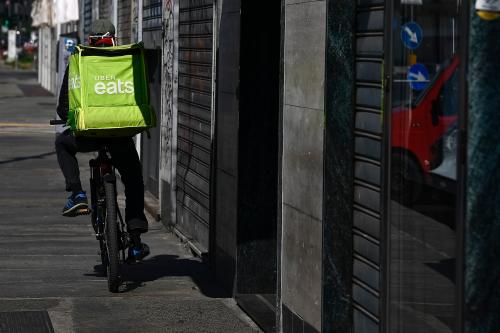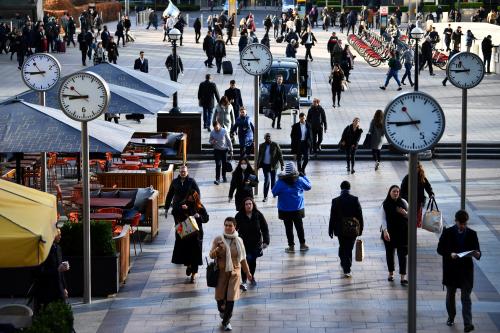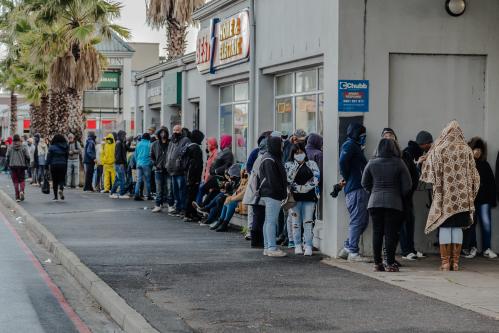More than a quarter of the world’s people are in quarantine or lockdown in response to the coronavirus (COVID-19). Tens of millions are required to stay at home, with many of them laid off or on unpaid leave. Given the highly contagious nature of the virus and the absence of a vaccination or cure, the mandatory nature of lockdowns and quarantines—to maintain physical distance—is understandable. Without government intervention, most private individuals, especially asymptomatic ones, would not self-isolate. Moreover, even with the intervention, there will be some “leakage.”
What is missing in such mandatory “stick” approaches is the more active use of “carrot” incentives that could both encourage self-isolation and help prepare a workforce to bounce back in the recovery phase. Noncompliance during a quarantine has large social costs, not least a faster spread of the pandemic and higher death rates. But governments could subsidize activities that help to better align private incentives with social objectives, and, in so doing, provide new forms of social protection that also make social distancing more bearable. What are some activities that could be performed by many citizens without leaving their homes?
We classify our ideas under three broad categories: jobs, human capital, and fun. The list could be expanded and we invite interested readers to submit their ideas.
Jobs. Here, we propose that governments subsidize a set of activities that could be done from home. This would further induce self-isolation, reduce the need for quarantine enforcement, and encourage some to learn new skills that could be useful after the pandemic is over. It could also provide effective, self-targeted social assistance to young people who have lost their jobs due to quarantines and lockdowns. Several categories of activities satisfy these criteria: data labeling, document digitization, and virtual services.
Data labeling is an area ripe for home-based work, and demand for such services, especially in health care, is high. The distribution and payment infrastructure is ready and easily scalable. Data labeling is critical for using artificial intelligence (AI). For AI to “learn,” somebody has to label data supplied to it, as in, for example, the automation of health care, which requires interpreting x-rays, recording medical procedures like colonoscopies, and so on. Humans must first identify polyps on the picture of intestines to train AI algorithms to detect abnormalities. People also label recordings of coughs, help improve automatic translations, interpret street scenes that feed into algorithms for self-driving cars, and provide myriads of other labeling services. More than 80 percent of the time devoted to developing AI algorithms is spent on data labeling. Labeling does require training, but many of the tasks could be learned quickly. We all have done data labeling: passing the CAPTCHA filters when setting up our passwords—remember identifying the road signs in a grid of pictures?
Another high-potential area is document digitization: Only 10 percent of the world’s books are digitized. Even with the current level of optical character recognition (OCR) technology, for a book to be digitized, an independent person needs to check it for errors, problems with tables and images, tagging, and oversee the look of the resulting text. Handwritten documents, images, and tables, even in printed books, require manual processing, proofreading, careful checking, and quality control. A person would receive scanned images of, let’s say, old letters to decipher and type into the electronic document. Comparing the results of several independent people working on the same document would assure the quality of transcription. The Rainfall Rescue Project of the U.K.’s Met Office aims to digitize 65,000 pieces of paper that contain monthly and decadal rainfall totals at thousands of weather stations across the U.K. from 1950 back to 1820. Because of their public-good nature, such projects are underfinanced. The global research community and libraries around the world would benefit from government support of these efforts. And many people could earn income and be kept occupied at home, inputting historical climatic data in spreadsheets.
Even before the pandemic, countries of the Nordic region—Norway, Sweden, Finland, and Denmark—had started the Smart Digital Health approach in caring for the elderly population. For example, virtual nurse visits are set up to check on elderly clients throughout the day to make sure they take medication and eat on time. And in other countries, there are also social support groups like Turn2me or Mental Health America that help people cope with anxiety, depression, and general mental health issues. Social workers set up remote dinner groups, take people virtually to concerts and shows, and keep company for single elderly people. Such services could surely be expanded during these times.
Human capital. Extended bouts of self-isolation could lead to wasted human capital. Digital jobs are one way to alleviate this concern. Another could be for governments to subsidize the dissemination and provision of Massive Open Online Courses (MOOCs) to make them freely and readily available.
Fun. Government could subsidize greater access to web-streamed entertainment services, because—in the current COVID-19 context—there is actually a public-good component in these privately provided services. Despite significant audience growth in recent years, many households still lack access to streaming services. And subsidizing household access to faster and more reliable Wi-Fi would also be fair game.
Our proposals come with a big and important caveat. They are largely geared towards incentivizing social distancing in rich countries. After all, there are millions of individuals who live in poor countries, with little or no access to even basic health care, and for whom social distancing is a luxury they can’t afford. Our proposals apply mostly to those who are already engaged in some online activities and have a roof above their heads.
Collectively, by aligning private and social objectives, these approaches would not only encourage stay-at-home behavior, but they would reduce compliance costs and help prepare a workforce to bounce back once the pandemic has passed. This is about more than just biding time at home. This challenging situation requires a modern take on “bread and circuses,” a strategy to keep people safe at home while putting bread on the table.








Commentary
Can public policy incentivize staying at home during COVID-19?
April 23, 2020